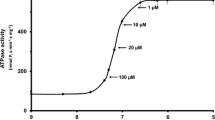Summary
The distribution of the sarcoplasmic reticulum and sarcolemmic tubules in the radula protractor muscle of the whelk, Busycon canaliculatum, has been investigated. The sarcoplasmic reticulum consists of an interconnected system of cisternae and tubular channels. The cisternae are closely associated with the sarcolemma. The tubular channels project from the cisternae into the interior of the cell and run parallel to the long axis of the myofilaments. Parallel tubular channels are interconnected with one another by short branches. This finding of an elaborate sarcoplasmic reticulum supports previous physiological work on this smooth muscle which indicated the presence of an intracellular compartmentalization of calcium ions. There is also an extensive system of tubular invaginations of the sarcolemma which we have termed sarcolemmic tubules. These tubules are 600 Å in diameter and about 0.5 microns in length. There is a substructure associated with the leaflet of the tubular membrane bordering the extracellular space. The sarcolemmic tubules penetrate only half a micron from the surface of the cell and interdigitate with the sarcoplasmic reticulum associated with the sarcolemma. Calculations have shown that the surface area of this smooth muscle cell is more than doubled by the presence of sarcolemmic tubules.
Similar content being viewed by others
References
Adrian, R. H., Peachy, L. D.: The membrane capacity of frog twitch and slow muscle fibers. J. Physiol. (Lond.) 181, 324–336 (1965).
Ebashi, S., Endo, M.: Calcium ion and muscle contraction. Progr. Biophys. molec. Biol. 18, 123–183 (1968).
Frank, G. B.: Utilization of bound calcium in the action of caffeine and certain multivalent cations on skeletal muscle. J. Physiol. (Lond.) 163, 254–268 (1962).
Heumann, H.-G.: Calciumakkumulierende Strukturen in einem glatten Wirbellosenmuskel. Protoplasma (Wien) 67, 111–115 (1969).
Heumann, H.-G., Zebe, E.: Über die Funktionsweise glatter Muskelfasern. Elektronenmikroskopische Untersuchungen am Byssusretraktor (ABRM) von Mytilus edulis. Z. Zellforsch. 85, 534–551 (1968).
Hill, A. V.: On the time required for diffusion and its relation to processes in muscle. Proc. roy. Soc. B 135, 446–453 (1948).
Hill, R. B., Greenberg, M. J., Irisawa, H., Nomura, H.: Electromechanical coupling in a molluscan muscle, the radula protractor of Busycon canaliculatum. J. exp. Zool. 174, 331–348 (1970).
Kawaguti, S.: Electron microscopy on sheathed muscle fibers of an opisthobranchiate mollusk. Biol. J. Okayama Univ. 14, 13–20 (1968).
Luft, J. H.: Improvements in epoxy resin embedding methods. J. biophys. biochem. Cytol. 9, 409–414 (1961).
Mashima, H., Matsumura, M.: Roles of external ions in the excitation-contraction coupling of frog skeletal muscle. Jap. J. Physiol. 12, 639–653 (1962).
Page, S. G.: A comparison of the fine structure of frog slow and twitch muscle fibers. J. Cell Biol. 26, 477–497 (1965).
Peachy, L. D.: The sarcoplasmic reticulum and transverse tubules of the frog's sartorius. J. Cell Biol. 25, No. 3, Part 2, 209–231 (1965).
Peachy, L. D.: Muscle. Ann. Rev. Physiol. 30, 401–440 (1968).
Reynolds, E. S.: The use of lead citrate at high pH as an electron-opaque stain in electron microscopy. J. Cell Biol. 17, 208–218 (1963).
Rogers, D. C.: Fine structure of smooth muscle and neuromuscular junctions in the foot of Helix aspersa. Z. Zellforsch. 99, 315–335 (1969).
Sanger, J. W.: Sarcoplasmic reticulum in the cross-striated adductor muscle of the bay scallop, Aequipecten irridians. Z. Zellforsch. 118, 156–161 (1971).
Sanger, J. W., Hill, R. B.: Ultrastructure of the radula protractor of Busycon canaliculatum. An unusual “T-system” in a molluscan phasic muscle. J. gen. Physiol. 57, 254 (1971).
Schlote, F. W.: Neurosekretartige Grana in den peripheren Nerven und in den Nerv-Muskel-Verbindungen von Helix pomatia. Z. Zellforsch. 60, 325–347 (1963).
Weber, A., Herz, R.: The relationship between caffeine contracture of intact muscle and the effect of caffeine on reticulum. J. gen. Physiol. 52, 750–759 (1968).
Winegrad, S.: Intracellular calcium movements of frog skeletal muscle during recovery from tetanus. J. gen. Physiol. 51, 65–83 (1968).
Author information
Authors and Affiliations
Rights and permissions
About this article
Cite this article
Sanger, J.W., Hill, R.B. Ultrastructure of the radula protractor of Busycon canaliculatum . Z.Zellforsch 127, 314–322 (1972). https://doi.org/10.1007/BF00306876
Received:
Issue Date:
DOI: https://doi.org/10.1007/BF00306876




